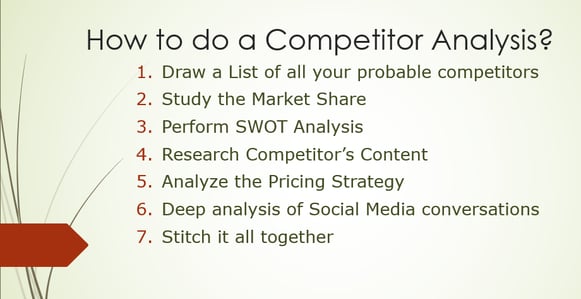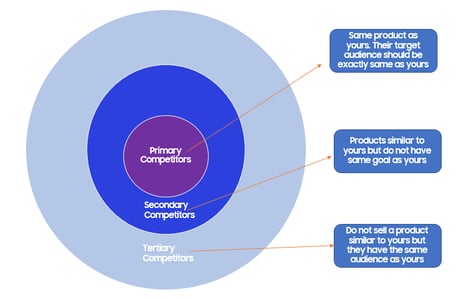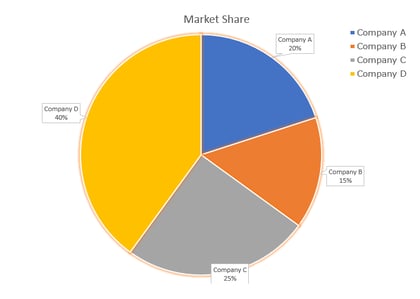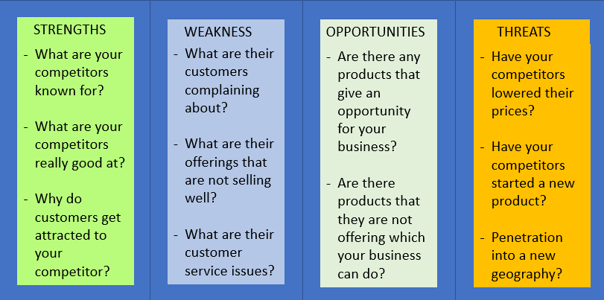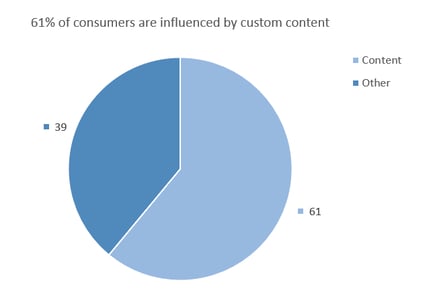I Don’t meet the competition. I Crush It! – Charles H. Revson | American businessman |
Just meeting the competition won’t get you anywhere. It is important to crush the competition by creating memorable experiences across your own customers’ journeys.
Small or big, all companies operate in a competitive landscape. Is there an escape to it? Sadly None!
But there is definitely a way to pose strong competition and outperform your competitors. Start by finding answers to some of the questions.
- Who are your competitors?
- What are their strengths?
- How are they able to outperform you?
- What are customers talking about your competitors?
When you become aware of your competitors – your chances of winning improves. But how can you do it?
This is where Competitor Analysis comes as your savior!
If you think you are already doing competitor analysis?
You may think that you are already doing a competitor analysis. Are you monitoring their social media pages, following the keywords which they rank on google and you very well know their new product launch!! This does not qualify as a good competitor analysis. It just gives you some information that anyone else already knows. Good competitor analysis is one that gives you deep insights about your competitors that can be used to make marketing and strategic decisions.
What Is Competitor Analysis?
Competitor Analysis Definition: Competitor Analysis is a process by which businesses gather information about competitors and the competitive environment, apply it to their planning and decision-making processes to improve their performance.
Competitor analysis is a powerful strategy to identify significant competitors. It can be used to conduct research on competitors’ products, advertising campaigns, sales, and marketing strategies. By using competitor analysis, brands can create robust business strategies that can help to improve upon its competitors. An effective competitor analysis will help to evaluate the strengths and weaknesses of your competitors in comparison with your own business strengths and weakness.
“World trade means competition from anywhere; advancing technology encourages cross-industry competition. Consequently, strategic planning must consider who our future competitors will be, not only who is here today.” – Eric Allison who is the Head of Aviation Programs at Uber.

Competitive Analysis Example
For example, Starbucks made use of competitive analysis to launch its dairy-free milk alternatives to stay ahead of its competitors. From 2012 to 2017, dairy-free milk alternatives in the U.S. grew 61%, with almond, coconut, and soy milk being the most popular types.
Understanding the consumer trends, and staying a step ahead of its competition, the company launched drinks with coconut milk in 2015 and began offering almond milk in 2016. Very soon, Starbucks started to offer oat milk in its European stores in 2018 to keep up with consumer trends.
Why is Competitor Analysis Important?
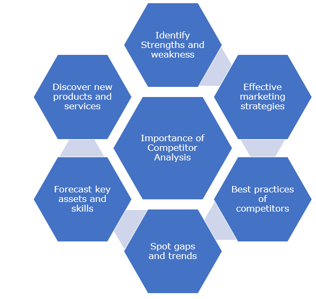 Competitor analysis is like a mirror!
Competitor analysis is like a mirror!
It displays your strengths and weakness within the market. And not just that, it can be of great use to exploit the weakness of your competitors. Competitor analysis has a great influence on shaping the company’s strategies.
Here we present reasons why competitor analysis is important for your company:
- Identify the Strengths and weaknesses of your competition
- Formulate effective marketing strategies
- Learn the best practices from a large segment of competitors
- Forecast key assets and skills needed to beat your competition
- Spot gaps and trends in the market
- Discover new products and services
How to do Competitor Analysis?
Competitor analysis can be done in 7 simple and easy steps:
- Draw a list of all your probable competitors
- Study the Market Share to evaluate your strength in the market against your competitors
- Perform SWOT Analysis to know where your competitors stand currently in the market.
- Research Your Competitor's Content
- Analyze the Pricing Strategy of your competitor
- Conduct a Deep analysis of Competitor’s Social Media conversations
- Stitch it all together
Now let’s deep dive into each of the steps of competitor analysis:
Step 1: Draw a list of all your probable competitors
This could look to be a simple step!
But in many cases, companies have no idea with whom they are competing. Even if they identify a few names, they could not be exactly their competitors. Therefore, it is very important to identify your competitors who are into a similar business like yours.
So, start BY categorizing your competitors:
A. Primary competitors:
Identify all such companies that are directly in competition with you. They should have the same product as yours. Their target audience should be exactly the same as yours. For example, Nike and Adidas are into exactly the same products. These are primary competitors to each other.
B. Secondary competitors:
Here all the companies that are selling products similar to yours but do not have the same goal as yours should go into this list. For instance, SuperPretzel is a secondary competitor of Spacely Games. Its revenue comes from selling soft pretzels. It produces a free mobile game called “SuperPretzel Factory”. This software is offered free to children as part of its content marketing. But this game can be an alternative to the paid game Spacely Games offers.
C. Tertiary competitors:
Tertiary competitors are all such companies that do not sell a product similar to yours, but they have the same audience as yours. Currently, they are not competition for you. But they can become future competitors when they expand their business. Body Armor and Gatorade both cater to young student-athletes. But their products are different. Gatorade is more of a sports drink, while Body Armor is a more natural drink.
After understanding the type of competitors, it's time to get a list of all your competitors. How do you get a list of all your competitors?
Start with a simple google search!
Search using keywords that relate to your business, such as product ideas, product offerings, product names, and product features. Think of yourself as a potential customer. What terms would you use to search your business? This will give you a list of probable competitors in your space. When you search for competitor analysis tools, you get a list of all probable names that offer similar tools.
The list will be quite long and uncategorized. You need to segregate further using additional information such as geography, history, number of clients, number of offerings, etc. When done, you have your list of competitors ready.
Now with this pool of competitors, you can move on to your next step.
Step 2. Study Market Share
Now turn towards understanding their market share.
The reason for checking the market share is simple – market share reveals how a company is doing when compared to the competition.
Market share is a metric used by companies to evaluate the effectiveness of revenue-generating efforts. Marketing campaigns, advertising impact, or branding initiatives can be measured by analyzing the market share. Market share is calculated by taking the total sales of a company and divide it by the total sales for the industry.
Let’s say ABC Fashions sold $5 million in apparel in the United States. The total market sales were $100 million in apparel during the same period. Therefore, the market share for ABC is 5%.
You can do such a calculation of market share to evaluate your strength in the market against your competitors. Market share denotes market presence.
With the help of market share, you can analyze the strengths and weaknesses of your competition, which takes us to the next step.
Step 3: SWOT Analysis
SWOT stands for Strengths, weaknesses, opportunities, and threats.
You need to know where your competitors stand currently in the market – Further, to get to know the way ahead and the challenges that you might face. Importantly you also need to know the resources that you may need to face your competition. SWOT analysis comes to help here.
Detailed SWOT analysis of your competitors can reveal a lot about you.
First, try to answer some of the questions.
Competitor Strengths:
-
What are your competitors known for?
-
Which aspects are your competitors really good at?
-
Why do customers get attracted to your competitors?
Competitor Weakness:
-
Is there something their customers complaining about?
-
List their offerings that are not selling well
-
Jot down their biggest customer service issues?
Opportunities That your competitor creates for you:
-
Are there any products that give an opportunity for your business?
-
Spot any such products that they are not offering that your business can do?
-
Notice any recent changes to their business that can become an opportunity for your business?
Threats that Competitors Pose:
As you can see from the SWOT analysis of your competitors, you stand to gain valuable insights into their business strategy. This, in turn, helps to design and improve your business.
Step 4: Research Your Competitor’s Content
As per research by Dragon Search Marketing, “61% of consumers are influenced by custom content.” Isn’t it surprising that content has such a huge influence!
A company can get a competitive advantage by using effective content. This leads us to the next step of competitor analysis.
Performing research on your competitor’s content will get your eyes and ears of your target audience. Start the research of your competitor’s content by following 3 important steps:
1. Look carefully at all the pieces of your competitors’ content
Take a complete inventory of the content produced by your competitors. Content gives insights into the level of investment that a company has done for its content. It gives hints on topics that are enjoyed by their audience. Importantly, you can spot the importance of topics and keywords used by your competitors.
Each content type has its own significance.
- Blogs: Articles published in the blog pages are a short content form that is used to provide insights into the business of the competitor. They generally have topics and keywords relating to their product offerings.
- Video content or Visual Content: The audience spends 88% more time on a website that has video. The volume and depth of videos posted on the competitor’s website can give you a deep understanding of the brand’s image.
- Presentations: A presentation posted by your competitors shows that they are investing in rich though leadership content.
- E-newsletters: Competitors might be using emails as a medium to send E-letters to reach out to their prospects and customers.
- E-books and white papers: Competitors can be publishing e-books, whitepapers, case studies, and research reports in a long-form of content for more targeted consumers with higher targeted topics.
2. Study each content type for quantity and quality
After gathering content samples from competitors, now its time to study each content type.
- Which keywords are getting them high visibility?
- Are you using the keywords that are used by your competitors?
- Spot type of content is shared the most? Do you have such content with you?
- Is there any specific kind of content that their audience likes the most?
- What are their publishing mediums? Which social media sites are they using?
- Who is referring traffic to your competitor’s site?
You can use a competitor analysis template to note down all your observations.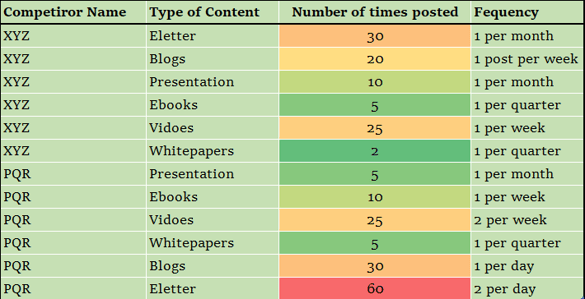
3. Deep dive into content pieces
By now you will have a broad understanding of the content produced by your competitor shortlist a few content pieces to deep dive into it. Focus on their most popular content forms and content pieces to prepare a map of your competitor’s content strategy.
Review each piece of content for its title, description, images, links, and keywords. You can now list down a set of keywords that matter the most for your competitor. At the end of this deep dive, you will have a master sheet of your competitor’s content strategy.
Using this spreadsheet, analyze the trends, frequency of publishing, coverage of each topic likes by the audience, and much more.
Step 5: Analyze the Pricing Strategy of your competitors
Competitor analysis is incomplete without comparing the pricing strategy of your competitors.
A key element of pricing your product correctly includes the continuous monitoring of your product prices as well as that of your competitors.
Collect pricing data relating to your competitors. Identify and group competitors based on:
- Cheapest price positioning
- Average positioning
- Highest price positioning
With this data, you can deep dive into how and why some competitors are able to offer lower prices, while some are charging a premium price. Study closely their quality, distribution channels, promotion strategies, and production strategies that will give you details on the reason for their pricing.
Based on the different models used by your competitors, you can carefully assess your business model and your current pricing. You could end up with a more viable option for your business.
Step 6: Conduct a Deep analysis of the Competitor’s Social Media conversations
If consumers strongly believe that your product is the best, then you are definitely the best.
But if they like your competitor’s product much better than yours, then you need to definitely dig deeper to find out more about it. Social media and online forums have emerged as a great resource to collect heartfelt opinions about you and your competitor’s products.
The analysis of the customer journey is no longer an easy and straightforward highway journey as it once used to be. Instead, it has a lot of twists and turns due to the emerging trends in the digital world.
Gone are the days when companies could analyze a few customers and come up with a marketing strategy. With the plethora of data available on customer preference and customer behavior, it is becoming humanly impossible to analyze the data manually. Artificial Intelligence has come up as a solution to this problem!
Social Media monitoring tools are of great help to get an idea of what your competitors are doing. With the help of Artificial Intelligence enabled tools, you can collect online and social media conversations relating to your competitors.
Take for example, by monitoring the online community forums, you can get to know the next big move of your competitor. It could be ideas that are posted by consumers. It could be an upcoming product launch or even a marketing campaign that can get your competitors ahead of you.
Competitor Analysis Conducted by Clootrack
Through the use of AI-enabled software, companies can gather a huge amount of social media data from their customers. Customer data can be converted into actionable insights that throw light on customer perceptions, customer behavior, and brand equity.
After a detailed analysis of 40,338 traveler and guest conversations, Clootrack analyzed 5 Top US hotels. With the help of AI and online customer data, Clootrack created a list of the top customer perception drivers. Each of the TOP 5 US Hotels was ranked based on customer perceptions.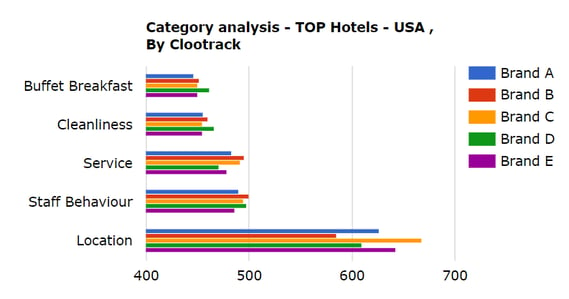
Competitor analysis helps you to identify areas where you are doing well. At the same time, this report will give you a clear picture of where your competitors are ahead of you in the
Step 7: Stitch it all together
Now that’s almost close to completion!
By now, you have got enough details about your competitors. You know their market share and pricing in comparison to your products. I am sure you have a list of their strengths, weaknesses, threats, and opportunities. Now that you’ve got all this info – It’s the right time to sort it and apply it to make it valuable. Content and social media have given you deep actionable insights about your competitors.
Start by identifying the areas where you need to focus, based on your goals. Categorize each finding into high, medium, and low priority.
For example, here is a simple competitor analysis template that you can use to note down the conclusions from your competitor analysis.
An effective competitive analysis indeed takes a lot of work. It cannot be done easily or overnight.
But look at the rewards – they are huge!
Competitor analysis equips you with all the information with which you can outsmart your competitors.
By delving into the customer data, brands can understand their position in the market. They get to see how they rank against their competitors. And not just that – There’s much more that can be done with competitive intelligence. And when powered with AI, competitor analysis tools can work wonders
Now stop letting your competitors race ahead of you!




